By Dr. Becker
This topic is a rather unpleasant but important one: assessing your dog's poop for signs of a health problem.
Since our canine companions can't tell us when they have cramps, a tummy ache, or some other digestive upset, it's up to us to stay alert for signs of trouble. One of the best ways to do this is to monitor not only what goes into your dog, but also what comes out of him.
What's 'Normal' Poop for Your Dog?
Generally speaking, a healthy canine stool is moist and firm, and has a mild odor.
Healthy Dog Stool
Dogs fed processed kibble (which I don't recommend) typically produce large quantities of voluminous poop for several reasons. First, most kibble manufacturers add unnaturally high amounts of fiber (beet pulp, soybean, and rice hulls, as well as "cellulose," otherwise known as wood fiber, or sawdust). The normal fiber content of the ancestral diet is between 4 and 6 percent. The fiber content of many dry foods is greater than 15 percent, and most "diet" or "lite" foods contain more than 28 percent fiber.
Dogs eating kibble also produce a stinkier poop because their bodies aren't designed to absorb certain nutrients in those diets (for example, grain and other starches, including the unnaturally high potato and pea content found in many "grain free" foods). In some instances, it can feel like your dog is passing out more volume of waste than the food volume she ate!
Stool of Kibble-Fed Dog
Raw fed dogs, on the other hand, tend to produce significantly less poop that is also smaller in size, firmer, and significantly less stinky. Dogs eating a high mineral raw food diet will produce poo that turns a much lighter color within 24 hours and disintegrates very quickly.
Dogs eating raw foods that could be too high in calcium or bone pass white, chalky feces, and may suffer from obstipation.
Stool of Dog Fed Raw Diet with Too Much Calcium
Regardless of your dog's diet, it's important to know what her poop looks and smells like normally so that you'll be immediately aware of any changes in frequency, consistency, size, color, or smell.
One of the most obvious signs of a potential health problem in dogs is diarrhea, and diarrhea can have different characteristics depending on its cause.
Types of Dog Diarrhea
In the following situations, unless the problem clears up on its own within a day or so, I recommend making an appointment with your veterinarian.
· A soft stool with no visible blood or mucous might indicate either a dietary change or indiscriminate eating. However, it can also signal the presence of an intestinal parasite such as giardia.
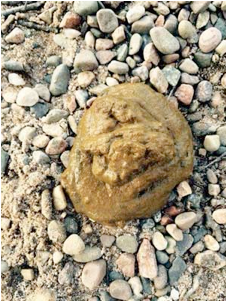
Soft Stool
· A greasy-looking gray stool can be a sign of too much fat in your dog's diet, which can trigger pancreatitis, which is inflammation of the pancreas that can range from very mild to life threatening.
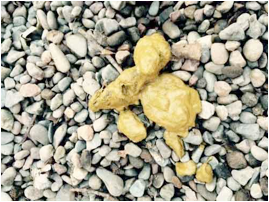
Excess Fat in Stool (Steatorrhea)
· A black, tarry stool typically indicates the presence of old blood somewhere in the dog's digestive system. It can be a sign of injury to the GI tract from indiscriminate eating, and it can also be a sign of a very serious disease such as cancer.
· Watery diarrhea can be a sign of stress or a viral (e.g., parvovirus) or parasitic infection and can lead very quickly to dehydration, especially in puppies.
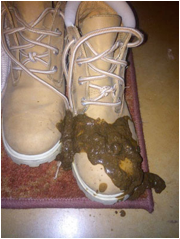
Watery Stool
· A soft stool containing or coated with mucous may indicate the presence of parvovirus or parasites.
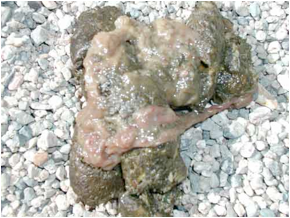
Stool with Mucus
· A soft or watery stool with visible worms, eggs, or other uninvited guests is a clear indication of a parasite infestation.
· Firm, soft, or runny poop containing blood or blood clots is almost always a sign of a serious health problem requiring immediate attention. Fresh blood indicates current bleeding, typically from the large intestine or the anus or anal glands. There could be a perforation of the intestinal wall from something the dog ingested, or from the eruption of a tumor or ulcer.
Causes of Diarrhea
Since diarrhea is a symptom of multiple health problems, it also has multiple causes. These include:
Change in diet
Toxins
Inflammatory bowel disease
Food intolerance, sensitivity, allergy
Idiopathic hemorrhagic gastroenteritis
Small intestine bacterial overgrowth (SIBO)
Intestinal parasites
Histoplasma enteritis or colitis
Indiscriminate eating
Tumors
Intestinal obstruction
Bacterial infection
Rectal polyps
Irritable bowel syndrome
Viral infection
Exocrine pancreatic insufficiency
Histiocytic ulcerative colitis
The Not-So-Obvious Symptoms of Diarrhea
When most of us think of a dog with diarrhea, we picture the poor pup standing anxiously at the door, needing to get out quickly. Once he's out, he dashes off to find a suitable spot and passes loose, watery stool. Alternatively, if we're not around when the urgency hits, we come home to an accident on the floor.
But what many dog parents don't realize is that sometimes diarrhea causes straining to go, making it look more like constipation than diarrhea. That's because diarrhea upsets the normal rhythm of the muscle contractions in your dog's intestinal tract, giving her the feeling that she constantly needs to poop. So even though she's hunched over and straining, her colon might be empty after repeated bouts of loose stool.
And in cases of chronic diarrhea, many dogs don't have accidents in the house and don't have fecal urgency, they simply always have loose, watery stools.
Other symptoms that can go along with diarrhea include fever, lethargy, malaise, loss of appetite, and dehydration. Puppies, small dogs, and seniors are at risk of dehydration from just one round of explosive diarrhea.
Small bowel diarrhea can also be confusing to owners, as the first part of the stool is firm, followed by soft or very loose second half of the bowel movement, which can indicate a variety of issues including small intestinal bacterial overgrowth, maldigestion, malabsorption, food intolerances, exocrine pancreatic insufficiency, dybiosis, or IBS.
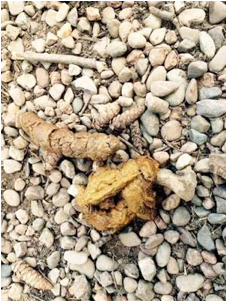
Small Bowel Diarrhea
When to Call the Vet
Most healthy dogs experience an occasional episode of loose stool or diarrhea that resolves within 12 to 24 hours. The underlying issue in most of these cases is indiscriminate eating or stress. However, any dog has the potential to become very ill from chronic bouts of diarrhea.
If your dog seems fine after a bout of diarrhea -- meaning she's acting normal, with normal energy – it's safe to simply keep an eye on her to insure her stool returns to normal within a day or so.
But if you notice she's also sluggish, running a fever or feels warm to the touch, or there's a change in her behavior, you should contact your veterinarian.
If you see blood in your pet's stool or she's weak or shows other signs of debilitation along with the diarrhea, you should make an appointment with the vet.
If your dog seems fine but is experiencing recurrent bouts of diarrhea, it's time for a checkup.
It's important to bring a sample of your dog's stool to your appointment, even if it's watery. Use a plastic baggie and shovel a bit in there to take with you. This will help your vet identify potential underlying causes for the diarrhea.
Home Care for Diarrhea in Healthy Dogs
If your pet is an adult, otherwise healthy, and behaving normally except for the diarrhea, I recommend you withhold food – NOT WATER – for 12 hours. At the 12-hour mark, offer a bland diet. I recommend cooked ground turkey and plain 100 percent pumpkin.
This is a different bland diet from the traditional ground beef and rice combination that is often recommended. Even the leanest ground beef contains a lot of fat, and fat can worsen a case of diarrhea. Rice, even though it's bland, is very fermentable. Fermenting rice in the colon of a pet with diarrhea tends to increase gassiness. Also, rice tends to just zip right through the GI tract, exiting with the next bout of explosive diarrhea totally undigested.
Mix the cooked ground turkey and pumpkin or sweet potato 50-50 in your dog's bowl. Feed 2 to 3 small meals a day until stools are back to 100 percent, which should happen in about 72 hours.
My favorite all-natural anti-diarrhea remedy is an herb called slippery elm bark. I recommend always having some on hand so when you need it, it's right there. Slippery elm is safe for puppies, adults, and geriatric dogs and it is completely safe when blended with other medications. I recommend about a half teaspoon for each 10 pounds of body weight, mixed into the bland diet twice daily.
I also recommend you add in a good quality pet probiotic.
Feeding a bland diet and supplementing with slippery elm bark is a good plan for about 3 days, at which time your dog's stool should be back to normal. If after 3 days the diarrhea hasn't cleared up, it's time to check in with your veterinarian.